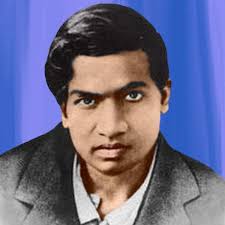
Srinivasa Ramanujan
(22 December 1887 – 26 April 1920 (aged 32))
Ramanujan was born in Erode, a small village in Tamil Nadu on 22 December 1887. When he was a year old his family moved to the town of Kumbakonam, where his father worked as a clerk in a cloth merchant’s shop. When he was nearly five years old, Ramanujan enrolled in the primary school. In 1898 he joined the Town High School in Kumbakonam. At the Town High School, Ramanujan did well in all subjects and proved himself an able all round scholar. It was here that he came across the book Synopsis of Elementary Results in Pure Mathematics by G. S. Carr. Influenced by the book, he began working on mathematics on his own, summing geometric and arithmetic series.
He was given a scholarship to the Government College in Kumbakonam. However his scholarship was not renewed because Ramanujan neglected all subjects other than mathematics. In 1905 he appeared for the First Arts examination which would have allowed him to be admitted to the University of Madras. Again he failed in all subjects other than mathematics, a performance he repeated in 1906 and 1907 too. In the following years he worked on mathematics, with only Carr’s book as a guide, noting his results in what would become the famous Notebooks.
He got married in 1909 and started looking for a job. His search took him to many influential people, among them Ramachandra Rao, one of the founding members of the Indian Mathematical Society. For a year he was supported by Ramachandra Rao who gave him Rs. 25 per month. He started posing and solving problems in the Journal of the Indian Mathematical Society. His research paper on Bernoulli numbers, in 1911, brought him recognition and he became well known in Chennai as a mathematical genius. In 1912, with Ramachandra Rao’s help, he secured the post of clerk in the accounts section of the Madras Port Trust. He continued to pursue mathematics and in 1913 he wrote to G. H. Hardy in Cambridge, enclosing a long list of his own theorems. Hardy immediately recognized Ramanujan’s mathematical ability. On the basis of Hardy’s letters, Ramanujan was given a scholarship by the University of Madras in 1913. In 1914, Hardy arranged for him to go to Trinity College, Cambridge.
Ramanujan’s work with Hardy produced important results right from the beginning. In 1916 Ramanujan graduated from Cambridge with a Bachelor of Science by Research. In 1918, he was elected a Fellow of the Cambridge Philosophical Society, a Fellow of the Royal Society of London, and a Fellow of Trinity College, Cambridge, all in the same year! However, from 1917 onwards he was seriously ill and mostly bedridden. In 1919 he returned to India, in very poor health.
Ramanujan made outstanding contributions to analytical number theory, elliptic functions, continued fractions, and infinite series. His published and unpublished works have kept some of the best mathematical brains in the world busy to this day.
Latest Govt Job & Exam Updates:
